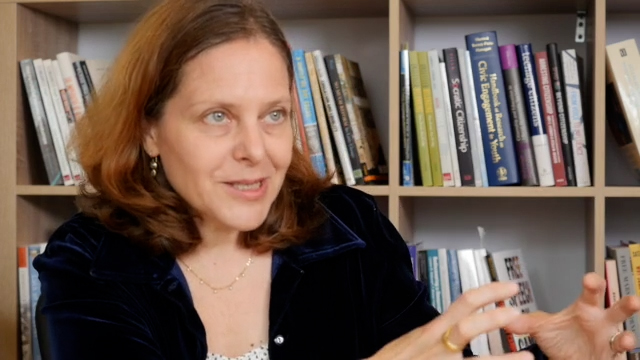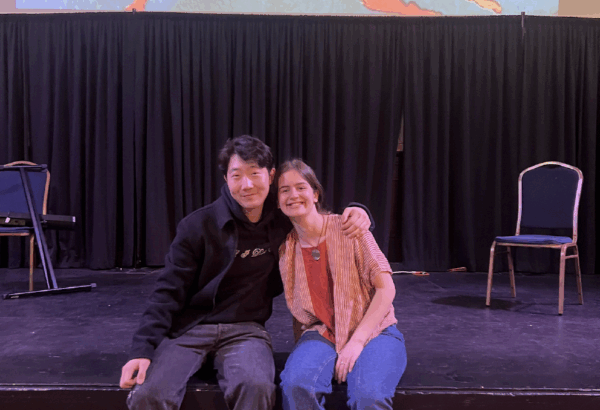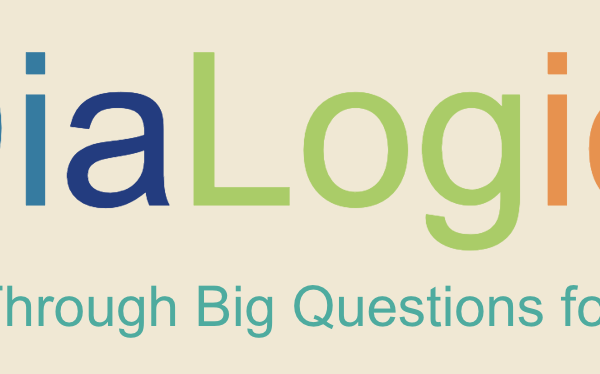Overview of Free Speech on Campus
This week, I’m reading Free Speech on Campus by Penn’s own Sigal R. Ben-Porath!
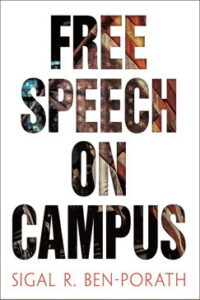
(For an introduction to this blog series on anti-oppression approaches to dialogue, see here for other entries in the series, see “Sarah’s Content” on this page.)
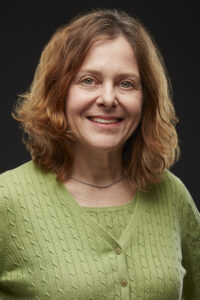
Sigal Ben-Porath is Professor of Education in the Literacy, Cultural Studies, and International Education Division of the Graduate School of Education (GSE) at the University of Pennsylvania. She also teaches in the Political Science and Philosophy Departments at Penn, where she has been teaching since 2004. Ben-Porath is interested in civic education and the ways in which schools and universities can uphold democracy, in part through the practice of democratic values on campus and in the classroom.
Free Speech on Campus is written in response to a series of highly publicized incidents on contemporary higher education campuses across the U.S. related to tensions over freedom of speech, including (among others) controversial invited speakers, hate speech, and indictments of administration and faculty for failing to adequately protect vulnerable students from the real harm of the latter and the perceived or feared harm of the former. It also rises out of the everyday challenges Ben-Porath faced while serving as chair of Penn’s Committee on Open Expression. In the short video below, Ben-Porath introduces the book in her own words:
As Ben-Porath indicates in the video, the book is structured around the concept of inclusive freedom, a framework for rethinking the relationship between inclusion and free speech. Ben-Porath notes in Free Speech on Campus that an unhelpful (and, in her view, false) binary distinction has been drawn between the responsibility to foster diversity, equity, and inclusion on college campuses on the one hand and the protection of First Amendment rights on the other hand. That is, it is assumed that to protect students from dehumanizing rhetoric and biased claims targeting their marginalized identities and experiences is necessarily to restrict freedom of speech. Meanwhile, it is assumed that to defend freedom of speech is necessarily to disregard or minimize the ways in which speech can increase in very real ways the vulnerability of students whose belonging on campus and/or in society already feels precarious due to social identity, immigration status, ideology, and so on.
An inclusive freedom framework, in contrast, places equal importance on inclusion (making sure that all potential participants in a dialogue enjoy truly equal access to that dialogue, in such a way that their identities and experiences are respected, their contributions are valued, and their forms of knowledge and expression are recognized as legitimate) and freedom (making sure that all ideas are able to be heard, even those that are distasteful, controversial, hard to hear, or illogical). Ben-Porath argues that freedom and inclusion are in fact mutually reinforcing: when one is genuinely committed to both concepts, to defend one is to defend the other. She explains, “When some members of the campus community are effectively barred from speaking, when they avoid speaking their minds for fear of humiliation or ridicule, or when they do not feel that they belong or that they are appreciated, free speech is limited just as much as it can be limited by censorship. Defenders of free speech should be worried about both types of limits” (62).
When suggesting groups of students that have been historically excluded and continue to be marginalized, Ben-Porath refers mainly to racial/ethnic minorities, LGBTQ+ populations, and women, with a few mentions of non-traditional (that is, older) students and ex-military students. Given her extremely well-taken emphasis throughout the book on access, I would have liked to see explicit consideration of dis/ability, broadly defined (and including trauma). However, this slim volume is, as I read it, less a prescriptive manual for how to “do” speech on campus (though Ben-Porath includes a number of practical considerations and suggestions) and more an invitation to further thought and conversation around inclusive freedom and the extension and application of her ideas. As an anti-oppression or social justice text, Free Speech on Campus does important work in respecting the unique vulnerabilities of marginalized and minority students when it comes to speech on campus, while centering their agency and right to freedom.
Major Concepts for Understanding Inclusive Freedom:
The graphic below provides a basic definition for ten essential concepts related to inclusive freedom. (Download of a PDF of this graphic or access the plain-text version, which also has somewhat expanded definitions, including examples.) Following the graphic are a few reflection questions inviting you to dialogue with these ideas through the lens of your own values, experiences, and goals.
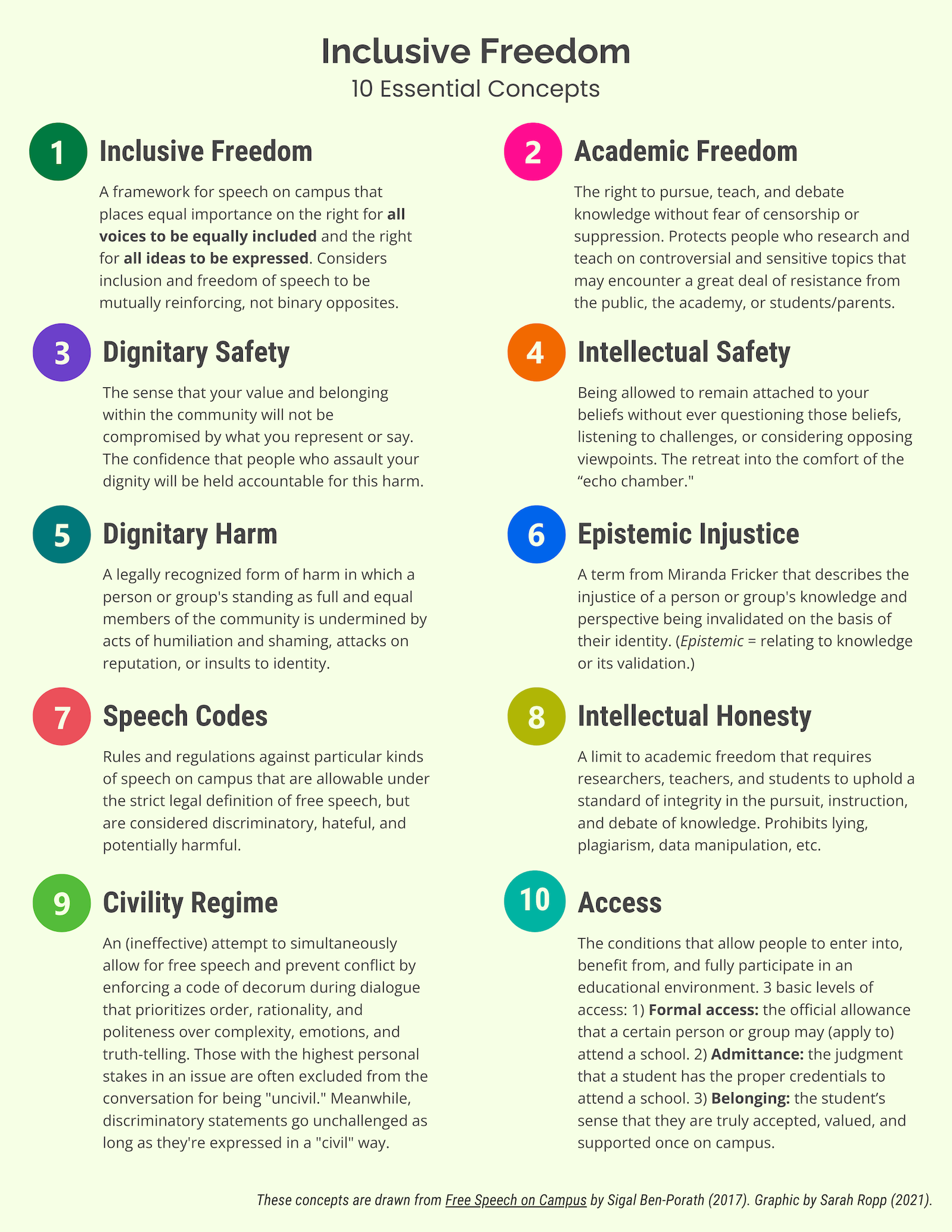
Questions for Reflection:
- Which of these concepts speak to you the most in relation to your own experiences on campus? Which do you find confusing or less relevant to your own experiences?
- Ben-Porath argues that the more context-specific concept of academic freedom should guide classroom speech rather than the more general First Amendment, because academic freedom is aligned to the goals of the classroom (sharing and constructing knowledge) and constrained by the demand for intellectual honesty (87). What is the relationship between epistemic injustice and academic freedom? That is, in what ways does epistemic injustice impede academic freedom and work against the goals of the classroom? How does epistemic justice contribute to intellectual honesty? That is, how does honoring and validating forms of knowledge that are historically dismissed or marginalized within the Western tradition support academic integrity?
- How do you respond to the concept of a “civility regime”? Do you believe there is a civility regime at work in your classes, in the campus events you tend to attend, or the extracurricular and community contexts you participate in? In what ways can a civility regime cause dignitary harm? In what ways can a civility regime work against access (especially the third level of access)?
- Rather than speech codes, which shut down certain words and forms of speech, Ben-Porath advocates opening up more, and more diverse, opportunities for speech. She writes, “Curtailing speech to prevent controversy is both unjustified and ineffective; instead, colleges should aim to enable multiple forms of expressive and political speech” What is your response to this idea? What are some new, creative, or underutilized “forms of expressive and political speech” that you can think of that might allow underrepresented people to speak on the issues that matter to them? That is, what formats besides the traditional lecture or panel discussion can you imagine as a vehicle for expression and debate?
- Similarly, rather than focusing only on protection from when it comes to vulnerable students and offensive speech, Ben-Porath emphasizes the necessity of cultivating freedom to: “While members of historically marginalized or currently vulnerable populations sometimes need protection from physical and verbal aggression, they are more commonly looking for a space where their voices can be heard and their identities or visions properly represented, affirmed, and expressed” (52). How is this a question of dignitary safety? Access? Epistemic justice? Have you ever experienced an affirming, inclusive space like this while at school? If so, what particular choices made by the instructor, other classmates, and/or yourself made that space possible? What particular forms of privilege and access made that possible? If not, what particular choices and forms of oppression and exclusion made that space not possible?
If you like this content and want more, follow us on social media and subscribe to our listserv.

